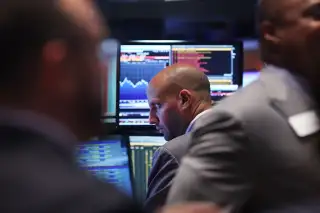3 Key Numbers That Will Show Where the Stock Market Is Headed

After Monday's roller-coaster ride on Wall Street—in which the Dow Jones industrial average sank more than 1,000 points in the morning, rebounded 800 points by midday, and then slid another 400 points—it's easy for investors to lose their bearings.
But even if the rockiness continues for several days, the market itself will provide investors with helpful guideposts.
Here are the three numbers that will help you understand where the market is and where it's headed:
1. Dow 14,650
As of Monday's close, the Dow industrials stood at 15,871. That means the benchmark index has fallen nearly 2,500 points, or 13%, from its all-time high of 18,312 in August, putting stocks squarely in a "correction."
For this downturn to morph into a full-blown bear market, signifying a 20% or greater loss, the Dow would have to fall another 1,200 points or so to 14,650. Is that out of the question? Given that the Dow lost more than 1,000 points in a matter of minutes Monday morning, absolutely not.
Psychologically, there's a huge difference between a market that slips into a correction and rebounds versus one that succumbs to a real bear. If the market nears 14,650 but bounces back, that's a good sign investors have not thrown in the towel on the bull market that started in March 2009.
If, on the other hand, the Dow hits this level and falls below, history says it will take more than a year for the market to shake off bearish thoughts.
2. VIX 40
The VIX is shorthand for the Chicago Board Options Exchange Volatility Index, which is a gauge of the market's expectation of future volatility. The higher the reading, the more likely that investors are bracing for rockiness ahead.
For months, the VIX has hovered in the low to mid teens, which is slightly lower than average. But after China's stock crash and economic slowdown began to infect the global markets, the VIX jumped to a reading of around 35.
The bulls are actually hoping to see it climb to 40 or higher.
Why? Isn't volatility a bad thing?
Not necessarily. While volatility is a byproduct of fear, which can send stocks reeling, a heavy dose of volatility can also be cathartic, which can end short-term selloffs. Historically, major market slides only ended after investors "capitulated" — the point at which folks are so scared they give up and disavow themselves from equities.
* When the S&P 500 fell nearly 19% in the summer of 2011 . . . selling didn't come to an end until investors began to capitulate in August, and the VIX jumped above 40.
* The same goes for the 2007-2009 bear market. Selling didn't wind down until fear had become so widespread that the VIX jumped above 40 and 50 from January through March.
* And as for the 2000-2002 bear market . . . the market didn't recover until after the VIX hit 40 — and stayed consistently above that level — in the summer of 2002.
3. Oil at $33 a barrel
While low oil prices can be a tailwind for corporate profits, the fact is oil prices are low because they reflect lackluster growth in the global economy. And if the global economy sours even further, that's bad news for earnings growth.
Crude oil, which had been trading as high as $50 a barrel in July, fell to $38 a barrel on Monday. Craig Johnson, technical market strategist for Piper Jaffray, points out that a key level of support for oil—the point that prices ought to stay above—is around $33 a barrel.
Should it fall below that level, look for another round of deflationary fears to grip the market, which will likely send stock prices and bond yields lower.
Read next: 3 Charts That Explain the Stock Market’s Huge Drop